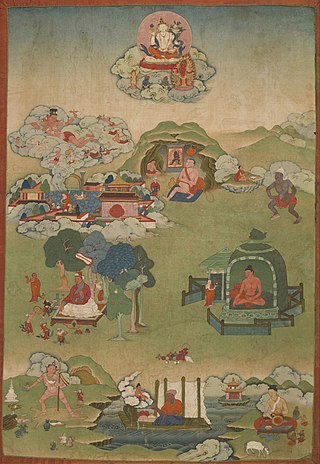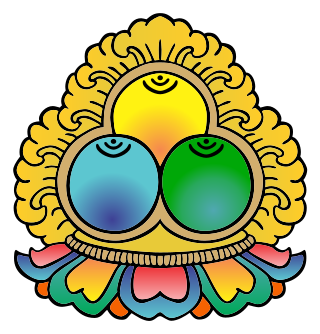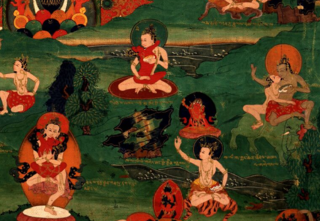
Tibetan Buddhism is a form of Buddhism practiced in Tibet, Bhutan and Mongolia. It also has a sizable number of adherents in the areas surrounding the Himalayas, including the Indian regions of Ladakh, Sikkim, and Arunachal Pradesh, as well as in Nepal. Smaller groups of practitioners can be found in Central Asia, Xinjiang, Inner Mongolia, and some regions of Russia, such as Tuva, Buryatia, and Kalmykia.

Vajrayāna, also known as Mantrayāna, Mantranāya, Guhyamantrayāna, Tantrayāna, Tantric Buddhism, and Esoteric Buddhism, is a Buddhist tradition of tantric practice that developed in the Indian subcontinent and spread to Tibet, Nepal, other Himalayan states, East Asia, and Mongolia.

Dzogchen, also known as atiyoga, is a tradition of teachings in Indo-Tibetan Buddhism and Bon aimed at discovering and continuing in the ultimate ground of existence. The goal of Dzogchen is knowledge of this basis, this knowledge is called rigpa. There are spiritual practices taught in various Dzogchen systems for awakening rigpa.

Padmasambhava, also known as Guru Rinpoche and the Lotus from Oḍḍiyāna, was a tantric Buddhist Vajra master from medieval India who taught Vajrayana in Tibet. According to some early Tibetan sources like the Testament of Ba, he came to Tibet in the 8th century and helped construct Samye Monastery, the first Buddhist monastery in Tibet. He is thought to have been born in the Swat Valley in modern-day Pakistan, and to have foreseen the arrival of Ngawang Namgyal, the founder of Bhutan. However, little more is known about the actual historical figure other than his ties to Vajrayana and Indian Buddhism.

The Gelug is the newest of the four major schools of Tibetan Buddhism. It was founded by Je Tsongkhapa (1357–1419), a Tibetan philosopher, tantric yogi and lama and further expanded and developed by his disciples.

Mahāmudrā literally means "great seal" or "great imprint" and refers to the fact that "all phenomena inevitably are stamped by the fact of wisdom and emptiness inseparable". Mahāmudrā is a multivalent term of great importance in later Indian Buddhism and Tibetan Buddhism which "also occurs occasionally in Hindu and East Asian Buddhist esotericism."
A yidam or iṣṭadevatā is a meditational deity that serves as a focus for meditation and spiritual practice, said to be manifestations of Buddhahood or enlightened mind. Yidams are an integral part of Vajrayana, including both Tibetan Buddhism and Shingon, which emphasize the use of esoteric practices and rituals to attain enlightenment more swiftly. The yidam is one of the three roots of the inner refuge formula and is also the key element of deity yoga. Yidam is sometimes translated by the term "tutelary deity".

Nyingma, often referred to as Ngangyur, is the oldest of the four major schools of Tibetan Buddhism. The Nyingma school is founded on the first lineages and translations of Buddhist scriptures from Sanskrit into Tibetan in the eighth century, during the reign of King Trisong Detsen.
In Tibetan Buddhism, Ngöndro refers to the preliminary, preparatory or foundational practices or disciplines common to all four schools of Tibetan Buddhism and also to Bon. They precede deity yoga.
Phowa is a tantric practice found in both Hinduism and Buddhism. It may be described as "transference of consciousness at the time of death", "mindstream transference", "the practice of conscious dying", or "enlightenment without meditation". In Tibetan Buddhism phowa is one of the Six yogas of Naropa and also appears in many other lineages and systems of teaching.

Longchen Nyingthig is a terma, revealed scripture, of the Nyingma school of Tibetan Buddhism, which gives a systematic explanation of Dzogchen. It was revealed by Jigme Lingpa (1730–1798).

Tibetan tantric practice, also known as "the practice of secret mantra", and "tantric techniques", refers to the main tantric practices in Tibetan Buddhism. The great Rime scholar Jamgön Kongtrül refers to this as "the Process of Meditation in the Indestructible Way of Secret Mantra" and also as "the way of mantra," "way of method" and "the secret way" in his Treasury of Knowledge. These Vajrayāna Buddhist practices are mainly drawn from the Buddhist tantras and are generally not found in "common" Mahayana. These practices are seen by Tibetan Buddhists as the fastest and most powerful path to Buddhahood.
The somaya, is a set of vows or precepts given to initiates of an esoteric Vajrayana Buddhist order as part of the abhiṣeka ceremony that creates a bond between the guru and disciple.

In Tibetan Buddhism, the Three Jewels and Three Roots are supports in which a Buddhist takes refuge by means of a prayer or recitation at the beginning of the day or of a practice session. The Three Jewels are the first and the Three Roots are the second set of three Tibetan Buddhist refuge formulations, the Outer, Inner and Secret forms of the Three Jewels. The 'Outer' form is the 'Triple Gem', the 'Inner' is the Three Roots and the 'Secret' form is the 'Three Bodies' or trikāya of a Buddha.

The fundamental practice of Vajrayana and Tibetan tantra is deity yoga (devatayoga), meditation on a chosen deity or "cherished divinity", which involves the recitation of mantras, prayers and visualization of the deity, the associated mandala of the deity's Buddha field, along with consorts and attendant Buddhas and bodhisattvas. According to the Tibetan scholar Tsongkhapa, deity yoga is what separates Tantra from Sutra practice.

Karmamudrā is a Vajrayana Buddhist technique which makes use of sexual union with a physical or visualized consort as well as the practice of inner heat (tummo) to achieve a non-dual state of bliss and insight into emptiness. In Tibetan Buddhism, proficiency in inner heat yoga is generally seen as a prerequisite to the practice of karmamudrā.
Karma in Tibetan Buddhism is one of the central issues addressed in Eastern philosophy, and an important part of its general practice.
In the Nyingma Tibetan Buddhist Dharma teachings faith's essence is to make one's being, and perfect dharma, inseparable. The etymology is the aspiration to achieve one's goal. Faith's virtues are like a fertile field, a wishing gem, a king who enforces the law, someone who holds the carefulness stronghold, a boat on a great river and an escort in a dangerous place. Faith in karma causes temporary happiness in the higher realms. Faith is a mental state in the Abhidharma literature's fifty-one mental states. Perfect faith in the Buddha, his Teaching (Dharma) and the Order of his Disciples (Sangha) is comprehending these three jewels of refuge with serene joy based on conviction. The Tibetan word for faith is day-pa, which might be closer in meaning to confidence, or trust.
Classes of Tantra in Tibetan Buddhism refers to the categorization of Buddhist tantric scriptures in Indo-Tibetan Buddhism. Tibetan Buddhism inherited numerous tantras and forms of tantric practice from medieval Indian Buddhist Tantra. There were various ways of categorizing these tantras in India. In Tibet, the Sarma schools categorize tantric scriptures into four classes, while the Nyingma (Ancients) school use six classes of tantra.
Illusory body is term for one of the Six Yogas of Naropa, also called luminosity. In his commentary, Pema Karpo says that the clear light is experienced briefly by all human beings at the very first moment of death, by advanced yogic practitioners in the highest states of meditation, and unceasingly by all Buddhas.













